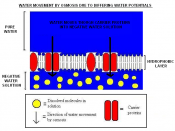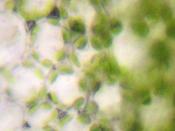All plants need water to survive. However, plants lose huge amounts of water through transpiration, which is the evaporation of water from the aerial surfaces of a plant. In order to understand this process, one must first analyze the structure of a plant.
Angiosperms are divided into two separate groups: monocots, with single cotyledons, or seed leaves, and dicots, with two cotyledons. Monocots usually have parallel veins in the leaf, complexly arranged vascular bundles, fibrous root systems, and floral parts in multiples of three. Dicots usually have netlike veins in the leaf, vascular bundles arranged in a ring, taproots (large, vertical roots), and floral parts in multiples of four or five.
Plants have evolved two different systems as an adaptation for living on land: the root system and the shoot system. The root system consists of subterranean roots and the shoot system consists of stems, leaves, and flowers. The root system absorbs water and minerals from the soil, and the shoot system obtains CO2 and sunlight and performs photosynthesis.
In order to transport the products of the shoot system to the root system and vice versa, the plant relies on a vascular system.
The vascular system consists of xylem and phloem. Xylem transports water and minerals from the roots to the shoot system, and phloem takes the food from the leaves and transports it to the rest of the plant. Xylem is formed from tracheids and vessel elements, two types of elongated cells. Tracheids and vessel elements are non-living. Tracheids are reinforced with lignin, providing the plant with structural support.
The plant is able to grow indefinitely because it has tissues that are always embryonic in the regions of growth. These tissues are called meristems. Apical meristems, located at the tips of the roots and buds of the shoots, allow...



Very good.
Thanks mate, much appreciated. You showed an in-depth understanding with justified reason which enabled me to further understand plants and in particular leaves. Thanks again, a well deserved A.
0 out of 0 people found this comment useful.